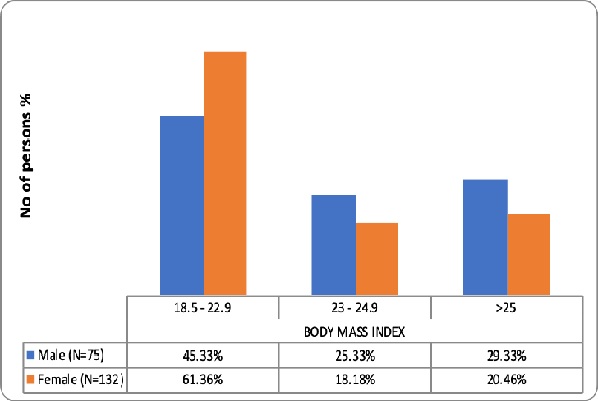Burden of combined obesity among students of a medical college in Guntur city of Andhra Pradesh
Abstract
Background: Obesity is a major public health problem especially in adolescent age group. Obesity is now recognized as a chronic or non-communicable disease. Medical students are not an exception to this fast spreading epidemic, despite their medical knowledge. Few studies in fact have reported higher prevalence among medical fraternity than general population. Also, based on scientific evidence of higher proportion body fat than muscle mass among Asian Indians, the actual prevalence may be higher than what is assessed by WHO cut off for BMI. In some cases central obesity is very high in individuals whom the BMI is normal. Both BMI and WC in combination would be better predictors of obesity related diseases than sole using of BMI or WC alone. Very limited knowledge is available on combined obesity. So, we planned this study to know its burden especially among medical students.
Methodology: It was a cross-sectional study at a medical college in Andhra Pradesh. A total of 207 medical students were selected from first and third semesters by simple random selection. Data was collected on sociodemographic data and the data of height and weight (BMI, General obesity), waist circumference (Central obesity). Finally, we estimated the burden of combined obesity (BMI+C.O).
Results: It was observed that 35 (16.91%) medical students were having combined obesity (obesity according to BMI and waist circumference G.O + C.O). Among them 15 (20%) are male, and 20 (15.15%) are female students.
Conclusions: The present study gives an idea about the high prevalence of combined obesity in the medical students. This should be an alert signal because medical students are the future doctors, health leaders and role models to the community. So, we need to identify specific barriers among medical students and come up with workable solutions.
Downloads
References
2. Verma K, Goyal S. Stress leading to overweight/obesity in First M.B; B.S. hosteller girls. Int J Collab Res Intern Med Public Health.2012;4(6) 924-33.
3. Shams N, Niaz F, Motwani R, Shaikh Z, Saleem F. Obesity and Hypertension in Female Medical Students; Frequency and Risk Factors. J Liaquat Uni Med Health Sci. 2015;14(01):26-32.
4. Purohit G, Shah T, Harsoda JM. Prevalence of Obesity in Medical Students and its Correlation with Cardiovascular Risk Factors: Emergency Alarm for Today? Kathmandu Univ Med J In Press.2015;13 (52):341-5. https://doi.org/10.3126/kumj.v13i4.16834.
5. World Health Organization: WHO Recommendations: Obesity: Preventing and Managing the Global Epidemic. Geneva, Switzerland, World Health Org., 2000 (WHO Technical Report Series No.894. [available from: https://www.who.int/nutrition/publications/obesity/WHO_TRS_894/en/].
6. Snehalatha C, Viswanathan V, Ramachandran A. Cutoff values for normal anthropometric variables in asian Indian adults. Diabetes care. 2003;26(5):1380-4. https://doi.org/10.2337/diacare.26.5.1380
7. Misra A. Body composition and the metabolic syndrome in Asian Indians: a saga of multiple adversities. Natl Med J India. 2003 Jan-Feb;16(1):3-7.[pubmed]
8. Dudeja V, Misra A, Pandey RM, et al. BMI does not accurately predict overweight in Asian Indians in northern India. Br J Nutr. 2001 Jul;86(1):105-12.[pubmed]
9. Banerji MA, Faridi N, Atluri R, et al. Body composition, visceral fat, leptin, and insulin resistance in Asian Indian men. J Clin Endocrinol Metab. 1999 Jan;84(1):137-44. DOI:10.1210/jcem.84.1.5371.[pubmed]
10. Sharma S, Raina SK, Bhardwaj AK, Chander V, Kumar D, Sharma S. Utility of Consensus Statement in Assessment of Obesity: A Study among Undergraduate Medical Students from Rural Northwest India. J Family Med Prim Care. 2013;2(3):274-6. https://doi.org/10.4103/2249-4863.120759.[pubmed]
11. Misra A, Chowbey P, Makkar BM, et al. Consensus statement for diagnosis of obesity, abdominal obesity and the metabolic syndrome for Asian Indians and recommendations for physical activity, medical and surgical management. J Assoc Physicians India. 2009 Feb;57:163-70.[pubmed]
12. World Health Organization. Waist Circumference and Waist Hip Ratio: Report of a WHO Expert Consultation. Geneva, Switzerland: WHO; 2011. [available at: https://www.who.int/nutrition/publications/ obesity/WHO_report_waistcircumference_and_waisthip_ratio/en/].
13. World Health Organization: WHO Recommendations: Obesity: Preventing and Managing the Global Epidemic. Geneva, Switzerland, World Health Org., 2000 (WHO Technical Report Series No.894 [available at: https://www.who.int/nutrition/publications/obesity/WHO_TRS_894/en/]
14. Selvaraj K, Sivaprakasam P. A Study on the Prevalence of Overweight and Obesity among Medical Students of Kanchipuram District. NJRCM. 2013;2(2):140-4) https://pdfs.semanticscholar.org/a890/a488aedc 705ec0b6e1b8c6a7aa4d1d1d2caa.pdf.
15. World Health Organization. Regional Office for the Western Pacific. (2000). The Asia-Pacific perspective : redefining obesity and its treatment. Sydney : Health Communications Australia. 2000. [Available at http://www.who.int/iris/handle/10665/206936]
16. Gudegowda KS, Vengatesan S, Sobagiah RT. Prevalence of overweight and obesity among medical college students, Bengaluru. Int J Community Med Public Health 2018;5:1881-6. https://doi.org/10.18203/2394-6040.ijcmph20181692.
17. Yadav SS, Saini P, Khan ZA, Bachloo T, Kumar R, Singh J. Assessment of body mass index among undergraduate medical students—a cross-sectional study from the Medical College of Haryana. Int J Med Sci Public Health 2016;5:705-708. https://doi.org/10.5455/ijmsph.2016.01092015116
18. Tiwari R, Jain V, Rajput AS, Bhagwat AK, Goyal M, Tiwari S. A study to assess prevalence of obesity among medical students of G.R. medical college, Gwalior, M. P., India. Int J Res Med Sci 2014;2:1412-6. https://doi.org/10.5455/2320-6012.ijrms20141132
19. Adhikari A, Dey I, Mandal NK. A Study on Overweight & Obesity and its Risk Factors among Undergraduate Students of a Medical College in Kolkata. J Comprehensive Health. 2015;3(2):42-51. http://www.journalofcomprehensivehealth.co.in/archive/july2015/july2015.html
20. R. Parimalavalli, A. Vijayalakshmi & S. Radhai Sri. Anthropometric Profile and Nutrient Intake of Overweight/Obese Women. J Human Ecology. 2009;26(2):131-35. https://doi.org/10.1080/09709274. 2009.11906174
21. Anyanwu GE, Ekezie J, Danborno B, et al. Impact of education on obesity and blood pressure in developing countries: A study on the Ibos of Nigeria. N Am J Med Sci. 2010 Jul;2(7):320-4. doi: 10.4297/najms.2010.2320.

Copyright (c) 2019 Author (s). Published by Siddharth Health Research and Social Welfare Society

This work is licensed under a Creative Commons Attribution 4.0 International License.


 OAI - Open Archives Initiative
OAI - Open Archives Initiative


